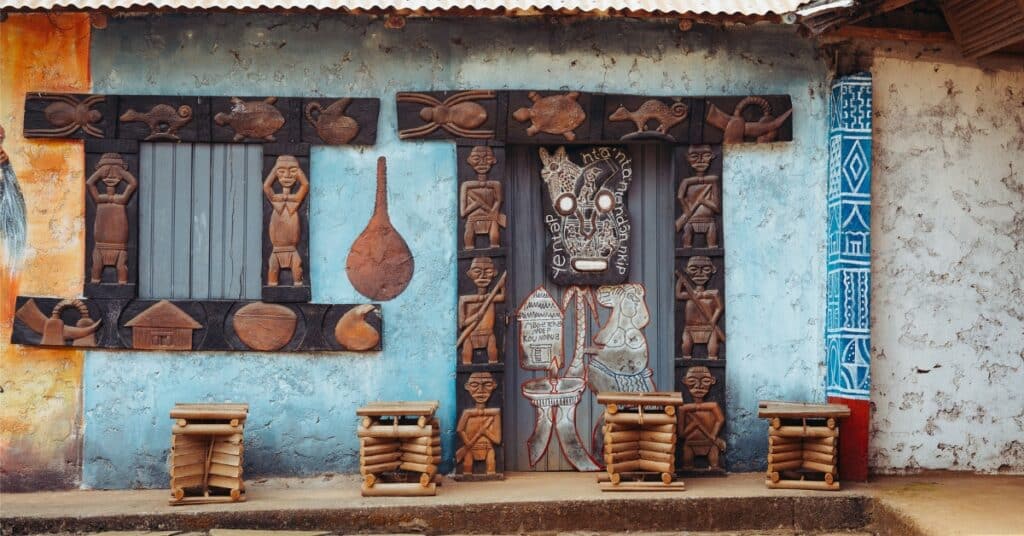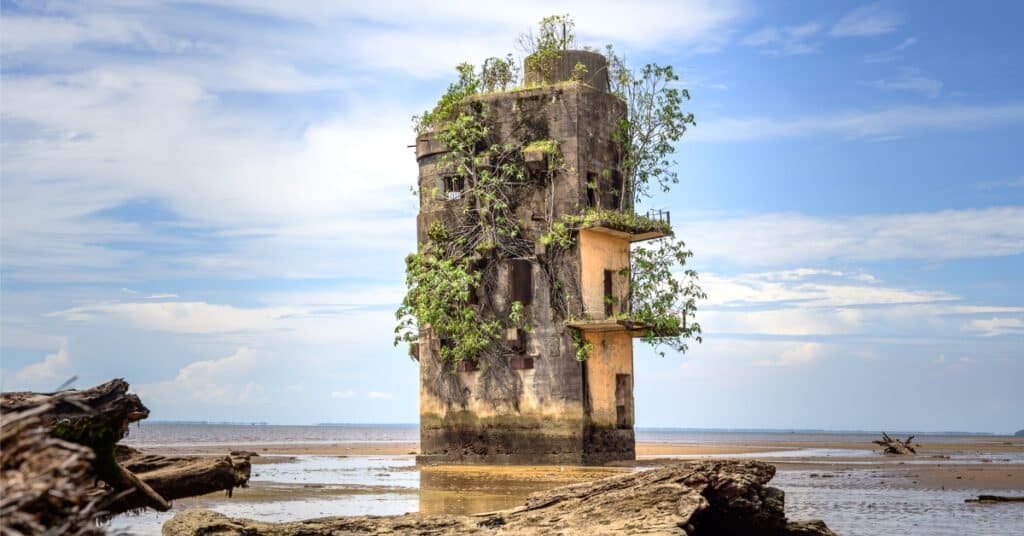D05 » Luxor, Among the Timeless Wonders of the Ancient Thebes
In the early hours of the morning, as the first light of dawn crept across the sky, our hotel-boat’s crew gently roused us from slumber with a timely wake-up call, pre-empting the alarm I had set for 5:00. The day ahead promised a rich tapestry of exploration, necessitating an early start. Luxor, our captivating destination, is steeped in archaeological marvels, primarily because it is the contemporary name for the ancient city of Thebes. This historic city served as Egypt’s capital from the 20th to the 10th century BC, a period brimming with tales waiting to be rediscovered.
Our itinerary included visits to five of Thebes’ most significant treasures. We explored the Valley of the Kings, a sacred necropolis where pharaohs found their final resting place. We marveled at the architectural grandeur of the Hatshepsut mortuary temple, stood in awe before the imposing Colossi of Memnon, and wandered through the hallowed halls of the renowned Luxor and Karnak temples. This journey marked our last day in a region overflowing with ancient wonders.
Following these enriching visits, we embarked on a drive to Hurghada, a renowned beach resort nestled along the shores of the Red Sea, some 300 kilometers east of Luxor. Awaiting us there were several days of well-deserved relaxation. Departing Luxor around 13:30, we arrived in Hurghada around 18:00, our journey punctuated by the mesmerizing landscapes of the desert, a vista that captured our imaginations and left us in awe of the natural beauty that lay beyond the sands.
As we prepare to delve into the narrative of this remarkable day, arguably the most varied and extraordinary of our Egyptian journey thus far, we find ourselves at the threshold of an exploration rich in diversity. The myriad sites we visited spanned a vast tapestry of different eras, promising a story both lengthy and captivating.
Settle in comfortably, as we embark on a journey that transcends millennia, transporting us back through the sands of time to an era several thousand years removed from our own.
Upon disembarking from the vessel, we embarked on a brief, yet transformative journey to the fabled gates of the Valley of the Kings. Guided by the whisper of dawn and the seasoned expertise of our guide, we found ourselves at the forefront of the day’s explorers, arriving as the first rays of light graced the world at 6:30. Standing there, I was enveloped in a profound sense of privilege, being the first to tread upon these ancient sands that day.
It was a moment that transcended the ordinary. As the valley lay enveloped in the lingering embrace of twilight, the surrounding peaks began to shimmer with the radiant gold of a sun newly risen. This encounter, forever etched in the canvas of my memory, stirred a deeply moving emotion within me.
Surrounded by the hallowed silence of the valley, I was vividly aware of the vast expanse of time that lay between us and the ancient pharaohs who found their final resting place here. This realization was not just a thought, but a profound experience, connecting me across the ages to the grandeur and mystery of a civilization long passed, yet alive in every grain of sand and whisper of the wind in this sacred place.
Steeped in historical and archaeological significance, the Valley of the Kings is an ancient burial ground in Egypt. Located in the Theban Hills on the west bank of the Nile River, this site served as the primary burial place for pharaohs and high-ranking officials during the period spanning from the 16th to the 11th century BCE.
The Valley of the Kings is divided into two main areas: the East Valley, which contains the majority of the royal tombs, and the West Valley, also known as the Valley of the Monkeys. Characterized by its barren, rocky terrain and a distinctive pyramid-shaped peak, Al-Qurn, this location was chosen for its remote and secure qualities, ideal for protecting the royal tombs from potential threats.
Originally, Egyptian pharaohs were buried in pyramids, like the famous ones at Giza. However, due to the vulnerability of these structures to tomb robbers, a transition occurred to hidden tombs in the Valley of the Kings. This change, happening around the 16th century BCE, represented a significant evolution in ancient Egyptian cultural and religious practices related to the afterlife.
The Valley features 65 known tombs and chambers, exhibiting varying sizes and complexities. The design of a typical tomb includes a descending corridor leading to the burial chamber and adjacent side chambers. Carved into limestone and other sedimentary rocks, these structures showcase the advanced architectural and artistic skills of the ancient Egyptians. The designs evolved over the centuries, with some tombs including multiple levels and pillared halls.
The tombs are renowned for their stunning artworks, carvings, and inscriptions, shedding light on the lives, beliefs, and funerary practices of ancient Egyptians. Decorations within the tombs, vital for rituals associated with the afterlife, depict scenes from the lives of the deceased, religious ceremonies, and mythological narratives.
The discovery of Tutankhamun’s tomb in 1922 brought international attention to the Valley of the Kings. Serving as the primary burial site for major royal figures and nobles of the New Kingdom, the Valley, despite most tombs having been looted in antiquity, still reveals the grandeur of Egypt’s pharaohs. Ongoing exploration and excavation, including advanced techniques like ground-penetrating radar, have led to new discoveries, enriching our understanding of this historical site.
Now recognized as a UNESCO World Heritage Site, the Valley of the Kings remains a testament to the splendor of ancient Egypt, captivating archaeologists and the public alike. It offers a unique glimpse into an ancient world that has significantly shaped our understanding of this remarkable civilization.
When purchasing your ticket to the Valley of the Kings, it is essential to be aware that this grants you access to only three tombs among the many that are available for viewing. Additionally, some tombs, like that of Seti I (KV 17), require an extra payment, amounting to about 1000 EGP (roughly 30 EUR at the time of this article).
We decided against paying additional fees and chose to visit the tombs of notable pharaohs. Guided by the recommendations of our knowledgeable guide, we chose to visit these three particular tombs:
The tomb of Ramses III (KV 11), a pharaoh famed for his comprehensive domestic building projects, a robust consolidation of law and order, and a notable tree-planting program. The lineage of Ramses III is often traced to the great Ramses II, although this connection remains a subject of scholarly discussion.
Next, we explored the tomb of Merenptah (KV 8), recognized for his military prowess, particularly his victories over the Libyans and the Sea Peoples. As the son of Ramses II, Merenptah’s rule was marked by significant military campaigns.
Our final visit was to the tomb of Ramses IX (KV 6), a ruler who descended from Ramses III and is remembered for a reign characterized by stability and prosperity. Each of these tombs offered a unique glimpse into the lives and legacies of these ancient rulers, deeply enriching our understanding of Egypt’s storied past.
We were immensely grateful for our guide’s advices. Each tomb presented a distinct character, with their own unique features and historical significances that set them apart.
Our early start proved advantageous, allowing us to capture stunning photographs of the site, unobstructed by the usual throng of tourists. This was especially beneficial in the narrow corridors of the tombs, where I was able to take my time, composing each shot with care and patience.
Time, however, seemed to accelerate in this enchanting place, and before we knew it, it was time to proceed to the next phase of our day’s adventure: the Mortuary Temple of Hatshepsut. Just a few minutes’ drive from the Valley of the Kings, located on the opposite side of the mountain, this remarkable site awaited our exploration.
The Mortuary Temple of Hatshepsut is an architectural marvel. Hatshepsut, the second recorded female pharaoh of Egypt, commissioned its construction soon after beginning her reign in 1479 B.C. The temple’s construction, which lasted about 15 years, reflects her ambition to establish herself as a legitimate ruler in a male-dominated society.
The temple, known as Djeser-Djeseru or “Holy of Holies,” is nestled against the cliffs of Deir el-Bahari and is renowned as one of the greatest architectural wonders of the ancient world. It consists of three massive terraces that rise above the desert floor, each marked by a double colonnade of square pillars, reaching a maximum height of 29.5 meters. Interestingly, one area of the temple, its chapel, employs proto-Doric pillars instead of the square pillars used elsewhere.
Hatshepsut’s temple is distinguished by its unique design and layout, which were likely influenced by the nearby mortuary temple of Mentuhotep II. Hatshepsut chose to build her temple adjacent to Mentuhotep’s, but on a much larger scale, to emphasize her own power and ambition.
The temple served multiple religious functions and hosted several shrines and chapels dedicated to various deities. These include the Chapel of Anubis, the god of embalming and the cemetery, located at the north end of the second level, and the Chapel of Hathor, the goddess associated with both Thebes and Punt, situated at the south end of the middle terrace. The most sacred area of the site, the Sanctuary of Amun, was cut from the cliff itself and located at the back of the temple.
The design of the temple reflects Hatshepsut’s effort to legitimize her reign, especially given her unique status as a female pharaoh. She established a special relationship with the god Amun, often claiming divine birth and portraying herself as the wife of Amun, which was the highest status an Egyptian woman could achieve.
The temple’s history also includes a period of desecration and erasure. After Hatshepsut’s death in 1458 B.C., her stepson, Thutmose III, sought to erase her legacy by removing her name and images from monuments. However, he left intact the story of her divine birth and expedition to Punt inside her mortuary temple.
Modern archaeological efforts have contributed significantly to our understanding of the temple. Excavation began in the 1850s and continued through the early 20th century, with further restoration and conservation efforts extending into the 21st century.
During our exploration, we lingered for an hour in the temple’s serene embrace. Fortuitously, our visit coincided with the early hours, allowing us to experience this sacred place in relative solitude.
As we journeyed towards our next destination, our guide unveiled an unexpected detour: a visit to a local stone cutter’s workshop. Here, skilled artisans demonstrated the intricate techniques once employed by ancient Egyptians in stone cutting and carving. This enlightening demonstration was followed by an opportunity to peruse the workshop, where the echoes of history resonated in every tool and artifact.
Upon discovering a magnificent bas-relief crafted from white alabaster stone, we envisioned it as a perfect addition to our living room. However, our enthusiasm was tempered upon learning its price, which seemed exorbitantly high. This moment served as a vital reminder of the essential practice of negotiation in Egypt, a cultural norm in many transactions.
Realizing that our budget would not align with the craftsman’s asking price, we gracefully exited the shop, where our guide awaited us. We then embarked on our journey to one of the most renowned temples of ancient Egypt: The Karnak Temple, a name that had long resonated in my mind, like Abu Simbel. En route, we paused for a few moments to marvel at the majestic Colossi of Memnon, a sight that added to the day’s tapestry of historical wonders.
The Colossi of Memnon are two monumental statues, each standing about 18 meters tall and weighing approximately 650 metric tons. These impressive structures were constructed around the 14th century BC, during the reign of Pharaoh Amenhotep III, who ruled in what is commonly referred to as the New Kingdom period in ancient Egyptian history.
Originally part of a larger mortuary temple complex, the Colossi were part of the most extensive such structure of its time, surpassing even the famed Karnak Temple in scale. This temple complex was dedicated to Pharaoh Amenhotep III, as well as the god Amun, serving as a site for the Pharaoh to commune with the deities and receive their blessings.
Symbolically, the Colossi represented the Pharaoh’s dominion over Egypt and his connection to Osiris, the deity associated with the afterlife. The bases of the statues feature depictions of his mother Mutemwiya, his wife Tiye, and the god Hapy, symbolizing rebirth and the notion of the king’s continual renewal.
One notable feature of these statues is the “singing” phenomenon associated with the northern colossus. After an earthquake around 27 BC caused damage to this statue, it reportedly began to emit a sound at dawn, a phenomenon that continued until repairs were made by Roman Emperor Septimus Severus in the early 3rd century AD.
The site of the Colossi holds significant historical importance. Thebes was a central location in the ancient Egyptian civilization. The Colossi have witnessed numerous historical events and have attracted tourists throughout the centuries, including during the Roman era.
The name “Colossi of Memnon” originates from the Greek hero Memnon, a figure in the Trojan War. The Greeks likely named the statues after Memnon due to their grandeur and imposing presence.
Today, the Colossi of Memnon remain a prominent tourist attraction, offering insight into the rich cultural and historical tapestry of ancient Egypt.
The stone giants, though not preserved in their full splendor, still speak volumes of their past grandeur. While much of their intricate details have succumbed to time, their sheer size remains a testament to their historical significance. Beyond their impressive scale, however, the site offers limited insights, rendering it more a monument to imagine than to study.
Our journey then led us to the bustling Karnak Temple, a melting pot of international visitors, each eager for their chance to step into this ancient marvel. The throng of tourists underscored my gratitude for our guide’s foresight in starting our day early. In the Valley of the Kings, such a crowd would have disrupted the serene solitude I took advantage of for my photography and contemplation, where I sometimes find myself lost in thoughts about the relentless march of time.
The Karnak Temple Complex stands as an extraordinary symbol of ancient Egyptian civilization’s architectural prowess, spanning a period of more than 1,500 years from the Middle Kingdom through to the Ptolemaic era. This complex was the central place of worship for the Theban triad of gods: Amun, Mut, and Khonsu, drawing pilgrims from throughout Egypt and beyond. Today, it stands as a prominent cultural and historical landmark, embodying the skill and dedication of the ancient Egyptians.
Covering an area exceeding 100 hectares, Karnak was not just a temple but a comprehensive religious city, home to priests, officials, and craftsmen who worked on the complex. Its construction is attributed to the efforts of various pharaohs and rulers over many centuries. Significant contributors to Karnak’s development include rulers from around the 21st to the 16th century BCE (Middle Kingdom) to those of the 4th to 1st centuries BCE (Ptolemaic Period).
Among the complex’s most remarkable features are its pylons, towering gateways that mark the entrances to different parts of the temple. These structures, mainly erected during the period from the 16th to the 11th centuries BCE, are not just architectural feats but also served as symbols of the pharaohs’ power. Decorated with intricate carvings and reliefs, they depict scenes from the pharaohs’ lives and their divine connections.
Central to Karnak’s religious significance was the god Amun, revered as the king of the gods and the creator of the universe. Amun, often represented as a man with winged headgear or as a ram, was associated with fertility, creation, and the sun. His cult, particularly influential from the 16th to the 11th centuries BCE, was central to the Egyptian empire’s religious structure.
The Karnak Temple is divided into various precincts, with the largest and most significant being the Precinct of Amun-Re. This precinct is home to the famous Great Hypostyle Hall, an awe-inspiring structure with 134 colossal columns. This hall spans approximately 103 meters by 52 meters, with the tallest twelve columns reaching heights of about 21 meters, supporting the central part of the building.
The complex’s history is intrinsically linked to the city, mirroring the city’s evolving role in Egyptian culture. Its development saw contributions from around thirty pharaohs, making it a site of unmatched size, complexity, and diversity.
Today, Karnak is the second-most visited historical site in Egypt, after the Giza pyramid complex. As part of the UNESCO World Heritage site, which also includes the Luxor Temple and the Valley of the Kings, Karnak continues to be a source of fascination and admiration for its historical significance and architectural magnificence.
Capturing the essence of our journey, we paused in the hypostyle hall, an architectural marvel where towering columns, once bearing a now-vanished roof, stood etched with ancient hieroglyphs. Their vibrant colors whispered tales from a bygone era. In this mystical setting, I photographed my wife, elegantly adorned in a dress crafted for this very moment, as she gracefully navigated the labyrinth of columns. We then allowed ourselves a moment of leisure, savoring a refreshing drink, indulging in light fare, and smoking the shisha.
Our adventure continued as we returned to our vehicle, setting our sights on the day’s final destination: the majestic Luxor Temple. This iconic site, steeped in history, is famously linked to Paris through its gifted obelisk. In November 1830, Muhammad Ali Pasha, the ruler of Ottoman Egypt, bestowed this ancient treasure upon the French people, forever intertwining the stories of these two distant lands.
Constructed predominantly during the New Kingdom, the Luxor Temple stands as a testament to ancient Egyptian civilization’s architectural ingenuity and spiritual depth. Pharaoh Amenhotep III initiated its construction in the 14th century BC, and it was expanded by rulers like Tutankhamun and Ramesses II. Made mainly from Nubian sandstone, the temple is a significant monument in Upper Egypt, also used extensively in restoration work over the centuries.
The temple’s architecture showcases the ancient Egyptians’ mastery of illusionism. Notably, its two entrance obelisks, despite their different heights, were designed to appear equal from certain viewpoints, reflecting the Egyptians’ understanding of perspective and symbolism.
Centuries of habitation and debris accumulation around the Luxor Temple created an artificial hill, obscuring much of its structure until late 19th-century excavations. These efforts, led initially by Professor Gaston Maspero, revealed the temple’s hidden courts and colonnades, previously integrated into the local village.
Ongoing conservation efforts address the deterioration of the temple’s sandstone, especially from salt-laden groundwater. These initiatives have included stabilizing structures and conserving and reassembling wall fragments from thousands of sandstone pieces found nearby.
The Luxor Temple was a primary religious center dedicated to the Theban Triad: Amun, Mut, and Khonsu. It played a central role in the Opet Festival, where a cult statue of Amun was paraded from the nearby Karnak Temple. This festival symbolized kingship rejuvenation and the divine essence of the Pharaoh and grew in duration over centuries.
The temple’s historical significance is multi-layered. During the Roman Empire, it served as a fortress and government building. In the 14th century, a mosque was built within its precincts, showing its continued religious importance across different cultures and eras.
Today, as part of the UNESCO World Heritage Site of “Thebes and its Necropolis”, the Luxor Temple is a vital link in understanding ancient Egypt’s religious and political life.
Upon concluding our tour of the majestic Luxor Temple, the moment arrived for us to part ways with Michel, our guide, who had been our faithful companion and knowledgeable mentor since our journey began in Aswan.
We extend our heartfelt gratitude to him for the rich explanations and anecdotes he shared, which vividly brought the ancient world of Egypt to life. His dedication to enlightening us, even during the Coptic Christmas season when he could have been with his family, is deeply appreciated and deserving of our utmost respect and recognition.
It was through his insights that we were transported into the mystical realm of ancient Egypt, bridging the gap between the illustrious Pharaohs and us, humble visitors from Cameroon.
We wish him the very best, knowing that his passion for sharing Egypt’s rich history will continue to inspire many more.
After we bid a heartfelt goodbye to Michel, our path led us from the historic grandeur of Luxor to the enchanting shores of Hurghada, the illustrious beach resort I alluded to at the beginning of this narrative. The journey was nothing short of magical, particularly the mesmerizing drive across the desert at sunset. There’s a certain kind of alchemy that occurs when the desert meets the twilight hour. The landscape transforms under the spell of the setting sun, with its warm light casting a golden glow over everything it touches, creating a canvas of radiant beauty.
This sublime spectacle stirred deep within me memories of a similar, soul-stirring experience in the Iranian desert some 15 years ago. In those moments, amidst the vast, silent expanse of sand and sky, time seems to stand still, and you find yourself enveloped in a cocoon of tranquil solitude. This feeling transcends mere nostalgia; it is a profound realization of being in complete harmony with the universe, a moment of deep connection with the world around you.
It’s in these instances that you feel an overwhelming sense of belonging, a comforting reassurance that you are exactly where you need to be. Everything falls into place, and there’s an indescribable peace that washes over you, a reminder of the beautiful simplicity and profound depth of our existence. These are the moments that remind us of the endless wonders our world has to offer, inspiring us to continue our journey with hearts full of awe and gratitude.
Roughly two hours into our journey, we took a brief respite at an oasis to nourish ourselves and stretch our legs. Amidst this serene backdrop, while enjoying our meal, a quaint and amusing scene caught my eye: a woman strolling with a donkey, which, quite amusingly, had a goat perched atop its back. The whimsy of the moment was too delightful to pass up, compelling me to capture it in a photograph.
This enterprising woman, it turned out, had trained her goat to ride on the donkey’s back as a unique way to draw the attention of tourists. Her ingenious idea wasn’t just about creating a spectacle; it was a clever means of livelihood.
She would offer tourists the chance to take a photo of this unusual sight in exchange for a small sum of money. Reflecting on my own experience, I found her strategy to be quite effective, as I happily contributed a few pounds for this charmingly unconventional photo opportunity.
This encounter was a vivid reminder of the resourcefulness and creativity found in every corner of the world. It speaks to the ingenious ways people adapt and find joy or subsistance in their daily lives, often turning the ordinary into something extraordinary. Such moments, while seemingly small, enrich our travels, offering unique stories and memories that stay with us long after the journey has ended.
We reached our hotel in Hurghada around 18:00, marking the end of our day’s journey. After indulging in a refreshing shower and a satisfying dinner, we were well-prepared to retire for the night. The next four days promised a welcome change of pace: a blissful period of ‘farniente’ – a delightful blend of relaxation, rest, and sunbathing.
This interlude was a much-anticipated respite, especially after the series of short nights we had experienced over the past five days. It was a perfect opportunity to recharge, basking in the serene ambiance and rejuvenating sunshine, allowing ourselves to fully embrace the leisure and tranquility of our surroundings.



